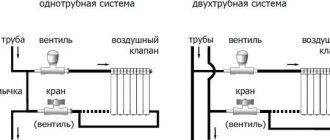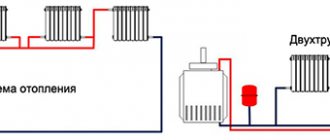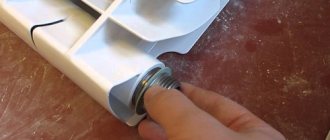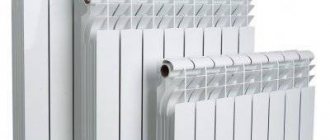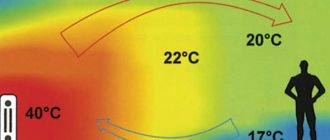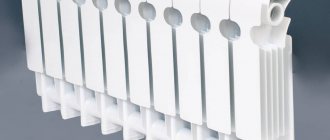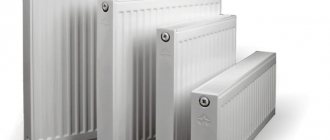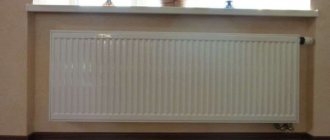Installation or repair of heating involves not only the selection of pipes and batteries, but also the method of connecting them to each other. The connection of system elements is carried out using gas or electric welding, threaded fittings. Each method has advantages and disadvantages, but in most cases, heating radiators are replaced by welding using a gas torch.
For what reasons may you need to replace your heating system?
In old houses, repairs to the heating system are usually not carried out from the day it was built. Therefore, it must be replaced in the following cases:
- when radiators or pipes began to leak due to wear;
- Heating radiators are replaced if heating of the premises is insufficient due to many years of deposits on the inner surface;
- when fuel consumption in autonomous heating systems increases due to clogged pipes;
- during a major overhaul.
Replacing heating batteries
There are many reasons for installing new radiators in your apartment heating system.
Such work is relevant both for secondary housing apartments and modern housing in new buildings. 3 most popular types of radiators
Aluminum radiators Aluminum radiators are characterized by a beautiful appearance and excellent heat dissipation. They are presented in three varieties: 500, 350, 200 mm. Radiators of this type are the most efficient type of devices. They are used both when creating new heat supply systems and when replacing old ones.
- Maximum coolant temperature 100-120 degrees
- Section capacity – 0.25-0.46 l
- Section weight – 1-1.5 kg
- Warranty – up to 15 years
Installation - from RUB 3,500.
Order a service Bimetallic radiators Rifar The Rifar company provides three models of bimetallic radiators to the market: 500, 350, 200 mm. One of the main advantages is their versatility; they can be installed both in multi-storey buildings with central heating and in autonomous mode. Specifications:
- Maximum coolant temperature 125-135 degrees
- Section capacity – 0.2-0.5 l
- Section weight – 1-1.5 kg
- Warranty – up to 15 years
Installation - from RUB 3,500.
Order a service Cast iron radiators Cast iron radiators have a traditional look. The design includes several sections connected to each other by nipples. The batteries are cast from gray cast iron. The material is wear-resistant and durable - radiators last more than 50 years. Cast iron conducts heat well and accumulates it into thermal energy.
- Maximum coolant temperature 125-145 degrees
- Section capacity – 0.5-1.4 l
- Section weight – 4-6.9 kg
- Warranty – up to 25 years
Installation - from RUB 3,500. Order service
Advantages and disadvantages of welding connections
The popularity of gas welding is explained by the specific functioning of heating systems. In addition to constant pressure, pressure surges and water hammer are possible during filling of the system. Since a seam made by gas welding exceeds the base metal in strength, such joints do not fail under extreme loads. The advantages also include:
- Long service life.
- Possibility of connecting parts of different shapes and sizes if the wall thickness does not exceed 3.5 mm. It is more economical to weld thicker metal using electric welding.
- Gas welding does not require electricity, which is important for new buildings.
- Reliable connection of pipes made of cast iron, copper, brass is done only by gas welding.
The main disadvantage is that when replacing batteries during welding, the surrounding space heats up. This may cause a fire if flammable items are not removed in advance. Finishes and heavy furniture are covered with heat-resistant material. When working with gas welding, harmful substances are released, so personal protective equipment is required.
Advantages and nuances
Today, replacing radiators of heating systems with gas welding is becoming increasingly popular. This is easily explained: the resulting weld at the junction of the radiator with the pipe (riser) is significantly stronger than the welded parts themselves.
Such a connection can withstand both strong water hammer and high pressure under which water is supplied to the heating system in all multi-apartment residential buildings. Using the gas welding method, you can prevent problems with leakage and failure of connections, as well as wear of its seal.
Who has the right to carry out gas welding work?
Welders who have been trained in a specialized educational institution and have a permit issued by the fire service are allowed to perform gas welding work. The validity period of the permit is limited, so when hiring a welder, you need to pay special attention to this point. He must be equipped with goggles, gloves, and a shield.
Before starting welding work, it is necessary to agree on the timing of its implementation with the employees of the management company. At the appointed time, the technician will come and close the risers and start the heating when the replacement of the batteries in the apartment is completed.
Attention!
Independent manipulation of the heating system in multi-storey buildings is prohibited.
Main stages
The choice of radiators is very wide: bimetallic, which is the most popular, aluminum, panel, cast iron. Each type has its own advantages and disadvantages, and the choice depends on the installation location and operating conditions.
Preparation and assembly
Before starting welding work, it is necessary to prepare the room: insulate the furniture, protect the walls and floor from possible damage. It is necessary to drain the water from the system and remove the coolant (in other variations). Next, using a grinder, you need to dismantle the used radiators
After all the preparatory work, you need to assemble a new battery for installation. To do this, the nuts at the joints are sealed with flax, coated with investment paste and tightened tightly. A special valve is installed on top to vent air, and an American ball valve with a squeegee is installed on the side of the connection with the pipe.
Installation
The new battery is installed on special brackets, after which all connections with pipes are adjusted - they are welded, and then the seams are cleaned. It should be taken into account that gas welding is usually used to connect pipes not exceeding 100 mm in diameter.
After welding work, it is imperative to check the system for strength and tightness. Replacing radiators using gas welding compared to the threaded method is a longer and more expensive process, which has some disadvantages. But quality, reliability and durability are an indisputable and winning advantage.
Selection and calculation of radiator power
When replacing heating batteries, it is not necessary to choose the same ones; you should pay attention to modern options made of steel, aluminum, copper, and alloys (bimetallic). But before choosing radiators, you need to clarify their size by performing simple calculations. If the ceiling height does not exceed 2.65 m, the number of sections is calculated based on the area of the room. It is multiplied by 100 W (this is the building norm per 1 m²). The resulting value is divided by the heat transfer value of one section indicated in the passport (standard 170 W), the result is rounded to the nearest whole number.
The process of replacing batteries in welding
If you intend to replace old radiators with batteries of a different type or change the number of sections, this must be agreed with the management company. You must also provide documents confirming that the work will be performed by a qualified welder. Self-dealing is punishable by a large fine.
Preparatory work
First of all, nearby furniture is removed from the welding site, and adjacent sections of the wall and floor are covered with non-flammable material. A specialist from the housing office is called in to shut off the heating and drain the water in an apartment building. In private houses and autonomous heating systems, a drain valve is provided for such cases. Then, using a grinder, the old batteries are dismantled. The pipes leading to the radiator must be cut straight so that there are no difficulties when installing a new one.
Assembling a new heating system
You can assemble and install a new heating battery yourself without calling a specialist. To do this you need to stock up:
- a set of nuts (for the battery);
- two ball valves;
- Mayevsky crane;
- investment paste;
- sealant made of flax or fum tape.
Before tightening, the nuts are treated with paste, and a sealant is wound around the threaded connections. Ball valves are installed on the supply and return pipes. They are necessary to disconnect the radiator from the heating system in emergency situations. On the other side of the battery, the Mayevsky tap is screwed in at the top. Air pockets, which often form in central heating systems, will descend through it.
Ball valves are required to be installed to shut off the radiator in emergency situations
Gas welding
The completed battery is placed in place, hanging on special mounts. To prevent air from accumulating inside, the installation of heating radiators is carried out according to the building level. Dirt is removed from the ends of the elements being connected and degreased. The supply and return pipes are connected to the radiator at an angle to prevent air pockets from forming. To prevent coolant circulation from being disrupted when closing the taps, a jumper from a pipe of slightly smaller diameter is welded onto the radiator between the supply and return.
Replacing radiators in an apartment RUB 2,500.
Standard installation on a threaded connection:
| Plumbing work: | Price in rub. |
| Replacing the 1st radiator (threaded connection) | 3500 |
| Replacing radiators (threaded connection) | 2500 |
| Installing a thermostat | 500 |
| Connecting the riser directly with removing the battery | 4500 |
| Consumables for threaded connection | 3000 |
Standard installation for electric and gas welding:
| Plumbing work: | Price in rub. |
| Replacing the 1st radiator (for welding) | 3500 |
| Replacing radiators (for welding) | 2500 |
| Installing a thermostat | 500 |
| Connecting the riser directly with removing the battery | 3500 |
| Replacing the heating riser | 4500 |
| Welding consumables | 3000 |
Departure of a specialist within the Moscow Ring Road - 800 rubles. + 50 rubles/km when traveling outside the Moscow Ring Road.
When concluding an installation agreement, this service is FREE.
Replacing heating batteries
Do you need to replace heating batteries that have practically stopped functioning, or install radiators in a new private country house in Moscow or the Moscow region?
Our company’s specialists are ready to provide you with professional assistance in this matter. High-quality installation of heating batteries in Moscow and the region is one of the main areas of our activity. Our craftsmen install heating radiators of any type in the shortest possible time (60 minutes per radiator).
When is it necessary to replace central heating batteries?
It is necessary to think about installing new heating batteries in those apartments where, in cold weather, old radiators no longer cope well with their functions. Stop complaining that your apartment is cold! Order the installation of radiators / new modern radiators, and your apartment will become the warmest! Removing and installing the heater radiator will not take much of your time, and the result will please all your household members.
If the central heating radiators in your apartment still work perfectly, replacing old ones and installing new radiators may be necessary if you are not satisfied with their appearance. For example, if you are planning to do a European-quality renovation in an apartment, then an old bulky cast-iron heating part will not go well with it. It is necessary to dismantle these outdated batteries and install modern, compact and powerful heating radiators.
New heating radiators, which should be installed by professionals, have an aesthetic appearance. They will fit perfectly into any interior. In addition, before installation, it is possible to select the color scheme and design of the heating radiators, which will be in harmony with the rest of the furnishings.
The main advantages of replacing heating radiators:
- high heat transfer (up to 2 sq.m. per section)
- modern design
- reliability
- ease of use.
Radiator installation and maintenance!
Did you need an urgent replacement of heating batteries in the winter (during the heating season)?
Do you need to install radiators with bottom connections in series or install heating radiators (radiators) from the floor in P-44 houses?
Have you decided to make a redevelopment and you need to reverse the heating radiators and replace convectors with steel radiators?
Do you need to install batteries from a gas boiler or replace batteries and radiators without welding?
Our company will always offer you a solution to all these problems. The most correct installation of batteries is carried out by our best specialists. Our company’s masters will quickly arrive in any district of Moscow (ZAO, NEAD, SEAD, TsAO, NEAD, SWAD, etc.) and the Moscow region to replace and install heating batteries.
Our best price for dismantling old batteries, as well as for installing a new heating radiator, will definitely pleasantly surprise you!
Is it possible to carry out work using electric welding?
If the owner of an apartment or private house is familiar with electric welding firsthand, he can independently replace the heating battery and pipes. This does not require permission from the fire department, since the work does not involve an open flame. For welding heating systems, it is better to get an inverter. It automatically maintains the arc parameters at a given level, so the seams are of better quality than when working with a simple welding machine. It is also important to be able to select the electrodes correctly, since the reliability of the connection depends on this.
After completion of the work, hidden flaws can only be identified after filling the system. In a private house there is no problem with this. For testing, the pressure on the boiler is set to 2 times the nominal pressure. In apartment buildings, if the replacement took place in the summer, you will have to wait for pressure testing, which is carried out before the start of the heating season. Any defects noticed must be reported to the house management or the welder who performed the replacement.
Read more about the differences
Replacing batteries using gas welding differs from the threaded method in several ways. So, in addition to the already mentioned aesthetics and the absence of massive nuts and fittings, gas welding allows you to create very strong connections.
Thus, in the threaded method, more than 12 seams are created, and in the gas welding method, as a rule, no more than 5. This protects the batteries from breaking through the heating system during pressure surges. The absence of seals also contributes to the durability of the structure.
The welding connection is indispensable, since this is the only way to replace batteries in high-pressure systems: the threads in such cases simply cannot withstand the load and the pipes break.
